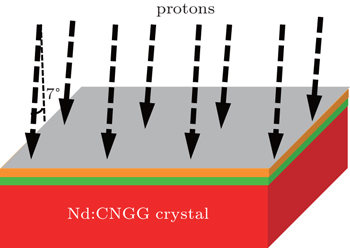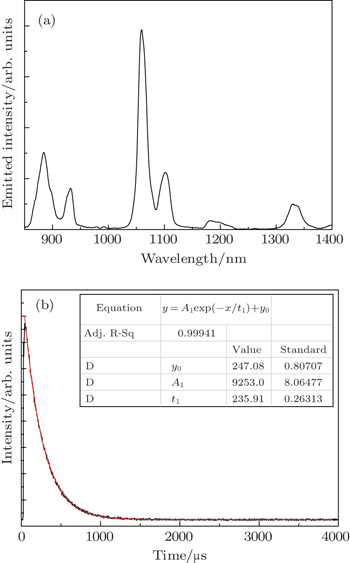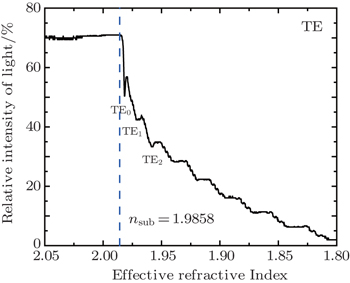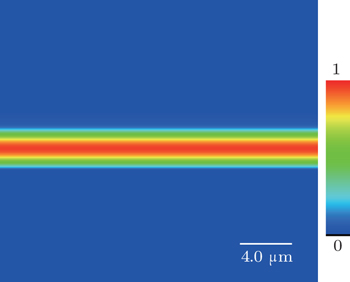† Corresponding author. E-mail:
‡ Corresponding author. E-mail:
Project supported by the National Natural Science Foundation of China (Grant Nos. 11405041, 61405240, 61077070, 61177086, 51002181, and 61177084), the Scientific Research Starting Foundation for New Teachers of Nanjing University of Posts and Telecommunications (NUPTSF) (Grant No. NY214159), and the Research Center of Optical Communications Engineering & Technology, Jiangsu Province, China (Grant No. ZSF0401).
In this work, the fabrication and optical properties of a planar waveguide in a neodymium-doped calcium niobium gallium garnet (Nd:CNGG) crystal are reported. The waveguide is produced by proton (H+) implantation at 480 keV and a fluence of 1.0×1017 ions/cm2. The prism-coupling measurement is performed to obtain the dark mode of the waveguide at a wavelength of 632.8 nm. The reflectivity calculation method (RCM) is used to reconstruct the refractive index profile. The finite-difference beam propagation method (FD-BPM) is employed to calculate the guided mode profile of the waveguide. The stopping and range of ions in matter 2010 (SRIM 2010) code is used to simulate the damage profile induced by the ion implantation. The experimental and theoretical results indicate that the waveguide can confine the light propagation.
Neodymium-doped calcium niobium gallium garnet (Nd:CNGG) is a kind of attractive laser crystal suitable for direct diode-pumping. It is a cubic crystal and belongs to the class of disordered crystal.[1] The crystal possesses the advantages of both Nd3+-doped glass and ordered crystals in some respects.[2] For example, it has a higher thermal conductivity than Nd3+-doped glasses and a broader pump absorption band than Nd3+-doped ordered crystals (such as Nd:YAG).[3] In view of the excellent optical properties, the Nd:CNGG crystal is a suitable candidate for fabricating a laser waveguide.
With the development of optical fiber communication and integrated optics, an optical waveguide, as a fundamental component of optoelectronics, has attracted more and more attention. It is characterized by a medium with a high refractive index surrounded by media with low refractive indexes.[4] Its basic principle to confine light propagation to dimensions on the order of micrometers is the internal total reflection occurring at the boundaries between guided cores and claddings. Although there are many methods to produce waveguides in optical materials, such as the diffusion of metal ions,[5] femtosecond laser inscription,[6] ion exchange,[7] sol–gel,[8] etc., the ion implantation is one of the most powerful techniques because of the wide applicability in materials and accurate control of both the penetration depth of implanted-ions and the concentration of dopants.[9,10] Therefore, combining outstanding optical properties of the Nd:CNGG crystal and the competitive waveguide technique of ion implantation to fabricate optical waveguides is an important research topic. Wang and Yu have fabricated planar waveguides in Nd:CNGG crystals by carbon ion implantation.[11] However, the penetration depth of proton is much larger than that of heavier ions (such as oxygen and carbon ions) for the same energy. This fact is especially advantageous for proton implantation when infrared light propagates in a waveguide. At the same time, the most characteristic wavelength of the emission spectrum in the Nd:CNGG crystal is about 1060 nm, which is in the near-infrared range. In the present work, we report on the preparation and optical characteristics of the planar waveguide in the Nd:CNGG crystal by H+ ion implantation.
The Nd:CNGG crystal with an Nd3+ concentration of 0.5 at.% was grown by the Czochralski method. It was cut into pieces each with dimensions of 10.0 mm×5.0 mm×2.0 mm and they were optically polished prior to any experiment. Its density, measured by the Archimedes method, was 4.69 g/cm3. The refractive index of the crystal substrate measured by a Metricon 2010 Prism Coupler was 1.9858 at a wavelength of 632.8 nm.
The crystals were placed in a vacuum chamber at a pressure of 10−6 Torr (1 Torr = 1.33322×102 Pa), and the implantation of the proton was carried out at room temperature by a 500-kV implanter at the Institute of Semiconductors of Chinese Academy of Sciences. Figure
Prior to the irradiation, the fluorescence spectrum of the Nd:CNGG crystal and the fluorescence lifetime of the 4F3/2 Nd3+ laser manifold in the crystal were measured by an Edinburgh FLS920P spectrometer (Edinburgh, UK) equipped with a near-infrared photomultiplier at room temperature.
After the implantation, the guided modes of the optical waveguide were measured by the standard prism-coupling method (a prism coupler, Metricon 2010). During the measurement, a rutile prism was employed to couple an He–Ne laser light with a wavelength of 632.8 nm into the waveguide. The refractive index distribution and the near-field modal profile of the waveguide were simulated by the reflectivity calculation method (RCM) and the finite-difference beam propagation method (FD-BPM), respectively.
Figure
Figure
Figure
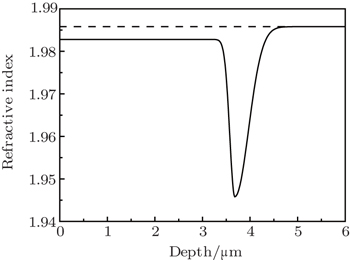 | Fig. 4. Refractive index profile of the waveguide (solid curve) and refractive index of the substrate (dashed line). |
| Table 1. Comparison between measured and calculated effective refractive indices for the proton implanted waveguide in the Nd:CNGG crystal. . |
The lattice damage caused by ion implantation plays an important role in the change of the refractive index of the ion-implanted waveguide. The stopping and range of ions in matter 2010 (SRIM 2010) code[16] is the most widely used calculation method to simulate the process of ion implantation based on the Monte-Carlo method. Figure
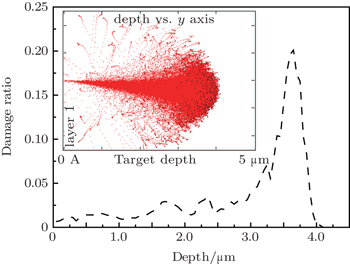 | Fig. 5. Damage ratio as a function of penetration depth of 480-keV proton in the Nd:CNGG crystal. The inset shows the lateral straggling of the implanted protons. |
FD-BPM is a competitive technique for simulating the propagation of light in optical waveguides.[20] Figure
In this work, optical planar waveguides in Nd:CNGG crystals are fabricated by 480-keV proton implantation with a fluence of 1.0×1017 ions/cm2. According to the m-line spectrum and the reconstructed refractive index profile, the waveguide is a barrier-confined structure at a wavelength of 632.8 nm. The simulation of FD-BPM suggests that the light of the TE0 mode can be well confined in the waveguide region.
| 1 | |
| 2 | |
| 3 | |
| 4 | |
| 5 | |
| 6 | |
| 7 | |
| 8 | |
| 9 | |
| 10 | |
| 11 | |
| 12 | |
| 13 | |
| 14 | |
| 15 | |
| 16 | |
| 17 | |
| 18 | |
| 19 | |
| 20 |



